This is a page on cat anatomy written for children and people who like straightforward English. The page focuses on the important bits only as this a very big subject.
The anatomy of the domestic cat which includes its muscles, nerves, bones, teeth, claws, hormones and senses, is almost perfect for hunting prey or escaping danger and is also almost exactly the same as the anatomy of a tiger or lion.
The cat can survive where other animals can’t, going without water and particularly food for longer than other domestic animals. There are lots of stories of cats being trapped for ages and surviving.
The cat can mate and produce kittens with great success. The domestic cat’s anatomy makes him very athletic with fantastic running, climbing and jumping skills. The anatomy is truly very impressive.
[“prey” means the animals the cat chases, catches, kills and eats]
The Cat’s Skeleton
The skeleton is light and strong. The bones of the skeleton are joined together by ligaments. Ligaments are like strong threads of string that connect one bone to another so the bones can work together. Cats have more bones than humans. The cat has 244 bones. A person has 206 bones. The biggest difference is in the cat’s tail where there are 19-28 bones.
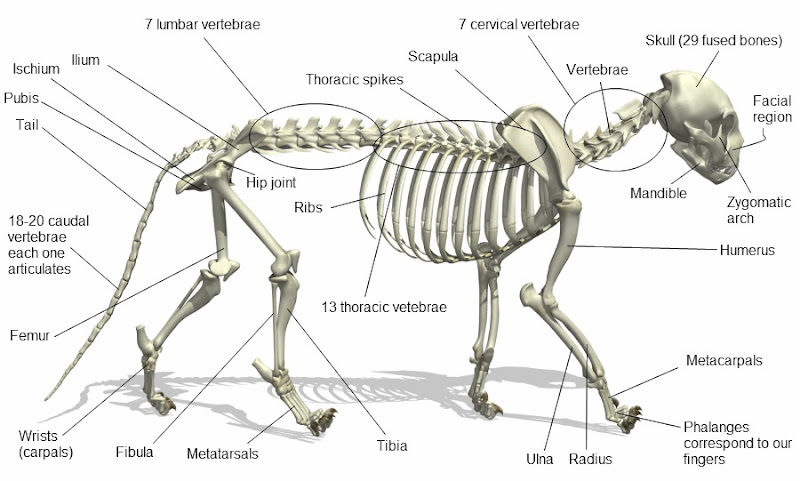
The cat’s skeleton does these things:
- red blood cells are made inside the bone. Red blood cells are needed to carry oxygen around the body in the blood.
- it protects the inside of the cat’s body and organs such as the heart, lungs, kidneys and so on.
- it supports the cat’s body. Without a skeleton the cat would be flat on the floor like a sloppy pudding.
- the bones of the skeleton work with the muscles so that the cat can jump, climb and run better than most other animals.
- the cat’s skeleton can bend a lot because the shoulder blade is not fixed to the main skeleton. The cat can run fast because of this.
- the holes in the skull for the eyes are very large because a cat’s eyes are much larger than the eyes of people compared to the size of the head.
The cheetah is the world’s fastest land animal because it has long bones, a big chest and a bendy body thanks to its skeleton.
Muscles

A message is sent from the cat’s brain through the nerves to certain muscles. The message makes the muscles contract (get smaller) or relax, which moves the bones of the skeleton and so the cat moves. Most of the cat’s muscles are able to contract very quickly. This means the cat moves fast and can jump long distances. The cougar is known as a great jumper. Two of this cat’s muscles are shown in the picture. Names in anatomy are always in Latin, a very old language. Experts like it that way.

Some of the muscles work without the cat asking them to work. An example is the muscles of the heart, which pumps blood around the body, keeping the cat alive.
Nerves
This picture shows how the nerves are set up in a cat:
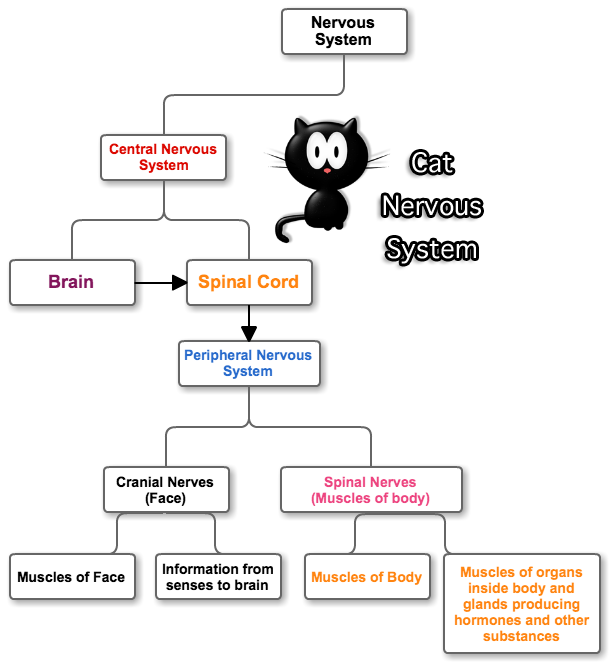
There are millions of nerves inside a cat. The nerve cells are called “neurons”. Nerves carry “messages” from the brain. They work a bit a like sending a letter to someone you know only the message in the nervous system is carried by a substance, a chemical called a “neurotransmitter” that creates an electrical “impulse”.
Cats control one part of the nervous system. So, for example, if a cat wants to jump the cat’s brain tells the muscles in the legs to contract (become shorter). The other part of the nervous system makes parts of the cat’s body work automatically like the heart and lungs.
Senses

The cat has high quality senses that are nearly always better than ours. They are:
- The cat’s whiskers are sensitive and feel the touch of a breeze in the air or an object. They can feel prey and help the cat to bite in the right place to kill animals particularly at night.
- Hearing and balance: the cat has great hearing. The ear is like a person’s ear in the way it is made. The inner part of the ear to do with balance. The cat has great balance too.
- Eyesight: the cat has high quality eyesight for nighttime but the cat sees color less well than people; the colour red is seen poorly. The cat’s eyes are special. They are like our eyes i the way they are made except they have a mirror behind them. This makes what they see brighter so they can see in the dark. Also, there is a third eyelid that protects the eye.
- A cat can sense where it is and how to get home. People think this is because the cat can sense where north, south, east and west is the the “magnetic field” of the earth.
- People believe a cat can sense earthquakes coming.
- Cats can taste well but cannot taste sweet things.
- A cat has a superb sense of smell. You will see a cat sniff almost everything to check it out, even you. The great sense of smell is because of their large olfactory bulbs. This is the part of the brain where smells are first analysed.
Heart and Lungs
Cats have a heart and lungs that are made for controlled movement and moments of high activity that requires lots of energy. The cat breathes in air through the nose, where it is filtered. The air passes through the windpipe to the lungs where oxygen in the air is transferred to the blood. The heart pumps the blood around the cat’s body.
The amount of blood in a cat is about the same as the amount of coke in a can. The cat has three blood types: A, B and AB. Most cats have type A. The type of blood in a cat depends on where the cat lives. In Switzerland all the moggies have type A. In Italy 89% of the cats have type A blood.
Teeth Stomach and Intestines
The adult cat has 30 teeth. They are called incisors, canines, premolars and molars:
Adult (permanent teeth) – emerge at about 4 months of age: I – 3/3 C – 1/1 P – 3/2 M – 1/1 = 15 x 2 = 30…
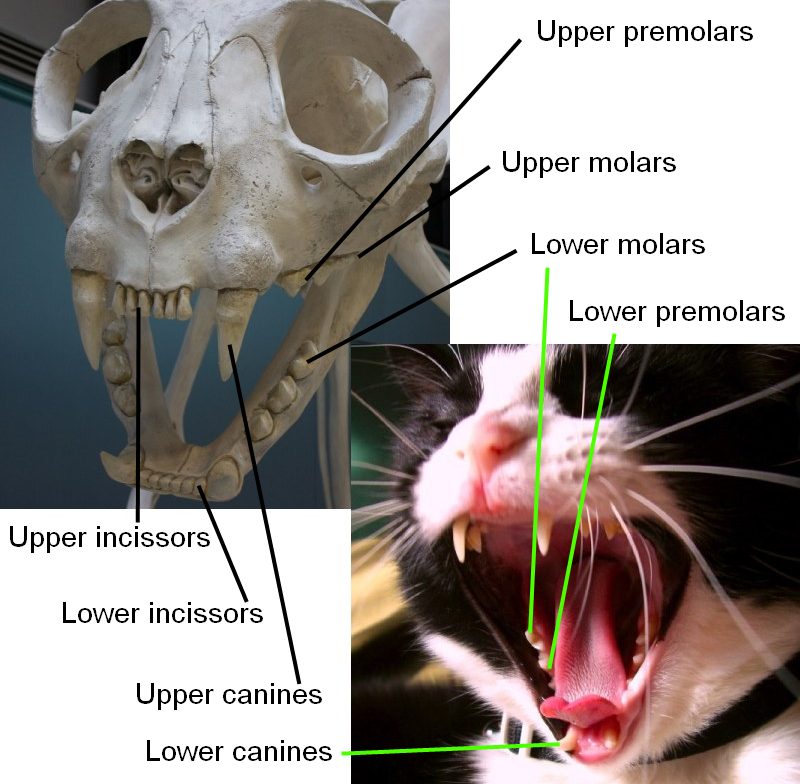
Food that is eaten is broken down so that is passes through the intestine into the blood to feed the cat. The cat’s “digestive system” is like ours but a bit simpler. The intestines are shorter than ours because the cat does not need to break down fiber in plants as it is a carnivore (the cat only eats the flesh of animals).
Claws
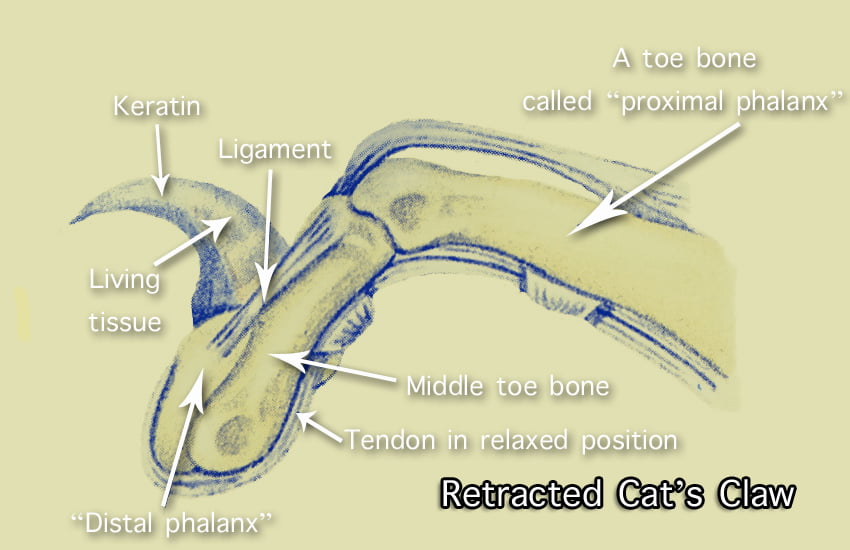
A cat’s claws are extremely important. They allow the cat to defend himself, catch prey, run and turn, mark places with scratches, groom himself, grip things so he can stretch, grip things he plays with. You can read all about a cat’s claws on this page. Cats walk on their toes. They are “digitigrades” which means an animal that walks on its digits (toes). When they run the claws help the cat to grip the ground. The claws of cheetah stay out because it needs them a lot of the time to run well.
Internal Organs
This pictures shows the organs inside the cat’s body.

This is what the organs are:
- Brain – controls the cat’s body. It is the center of the nervous system.
- Spinal Cord – connects brain to nerves of the body which control the body.
- Diaphragm – separates lungs from the organs lower down such as the stomach. It helps in breathing.
- Liver – a very important organ. It does lots of different things including getting rid of bad stuff in the body.
- Stomach – helps to digest food. This means it helps to make food ready so that it can be taken into the cat’s blood where the broken down food can feed the cat.
- Kidney – helps to keep the body stable and get rid of waste from the body.
- Large Intestine – part of the system that breaks down food so it can be used by the body.
- Anus – where solid waste leaves the body.
- Testis – part of the male cat’s reproductive system where sperm is created and which makes a hormone, testosterone, that makes a male cat male.
- Urethra – where waste liquid, urine, leaves the body.
- Bladder – where waste liquid, urine from the kidneys, is stored before leaving the body through the urethra.
- Spleen – filters the cat’s blood.
- Gallbladder – helps break down (digest) a substance in food called “fat”.
- Heart – pumps blood around the cat’s body through blood vessels. The heart contracts and expands in the same way, day and night, non-stop until the cat dies.
- Lungs – there are two lungs. They take oxygen from the air and make sure it gets into the bloodstream. Also they get rid of carbon dioxide, which is waste gas, from the body.
- Esophagus – called the “gullet” it is a tube that goes from the back of the mouth to the stomach. Food passes through it.
- Trachea – “windpipe” — the main tube that connects the mouth to the lungs. Air passes through it.
- Buccal Cavity – the inside of the mouth.
- Nasal Cavity – the inside of the nose.
The Coat
The cat’s coat is what see most when you look at a cat. Hair is mainly made of a hard susbtance called “keratin”. It is the same stuff that makes claws. There are hundreds of different colours and patterns of cat coats. The most common pattern is called a tabby cat. You can read about the tabby cat coat on this page. There are short haired and long haired cats. The long haired cats live in colder places. Whiskers are part of the coat and they are very sensitive to movement of any sort. Whiskers are thick hairs. They are not just around the mouth. If you look carefully you will see them in other places especially on the face.
There are three types of fur: undercoat (down), middle and top (awn) and top and the longest hairs (guard hairs). You can read more (for adults but straightforward) on this page.
The Skin
The skin defends the cat’s body from disease. There are two layers of skin: epidermis and dermis. The cat’s skin not only protects the organs of the body and makes fur it also makes scent which is the liquid that smells in a way that tells other cats that it belongs to a certain cat. Cats put this scent on things to tell other cats that they are around. This stops fights. It also tells other cats where a place is owned by a cat. The skin also makes an oily substance that keeps the skin elastic and helps protect it.
Skin Glands
This diagram shows the skin glands of the cat:
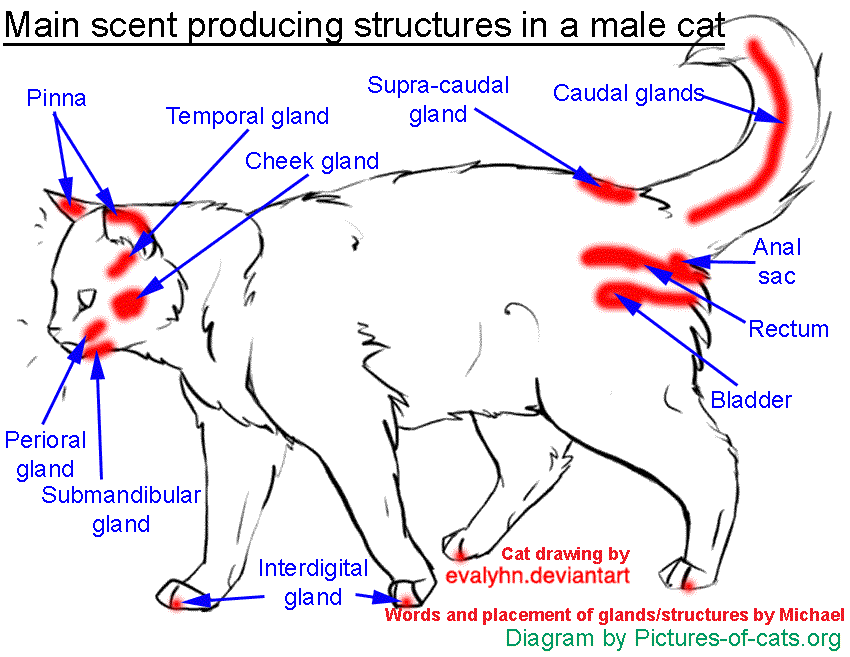
If you click on this link you can read about these glands.
Go to home page of PoC.

kyyguyuty